Eastern Massasauga (Sistrurus catenatus)
by Jeff LeClere
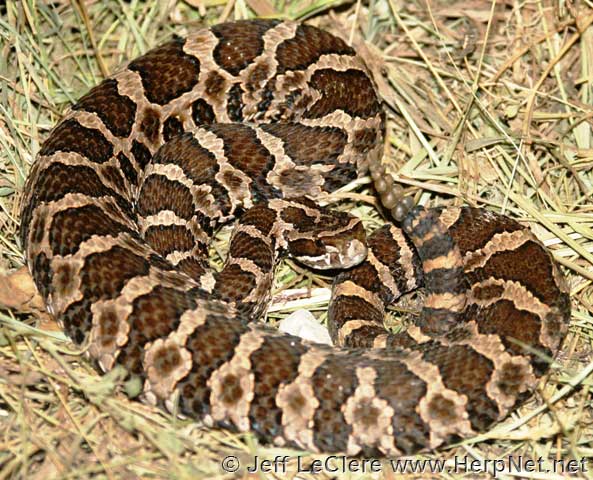
Status
ENDANGERED and Species of Greatest Conservation Need. It is illegal to kill or collect this species by law in Iowa. Reports are needed for parts of southern and eastern Iowa. Please report any sightings to us or the DNR.
Description
Dangerously venomous. This is a small rattlesnake that measures 17 – 39 1/2 inches in length (Conant and Collins, 1991). There is a row of black or dark brown mid dorsal blotches on a lighter brown or gray background. There are two or three rows of small spots on the sides. All blotches and spots may be outlined in white. The blotches usually turn into rings on the tail. There are usually five rings that are 3 – 3 1/2 scales wide and 11/2 scales apart. There is a rather broad dark stripe from the eye past the angle of the jaw. The belly is mostly black with irregular white or yellowish marks. Melanistic specimens are known; these specimens are uniformly black dorsally and ventrally. There are usually some light markings on the chin and throat that remain, however.
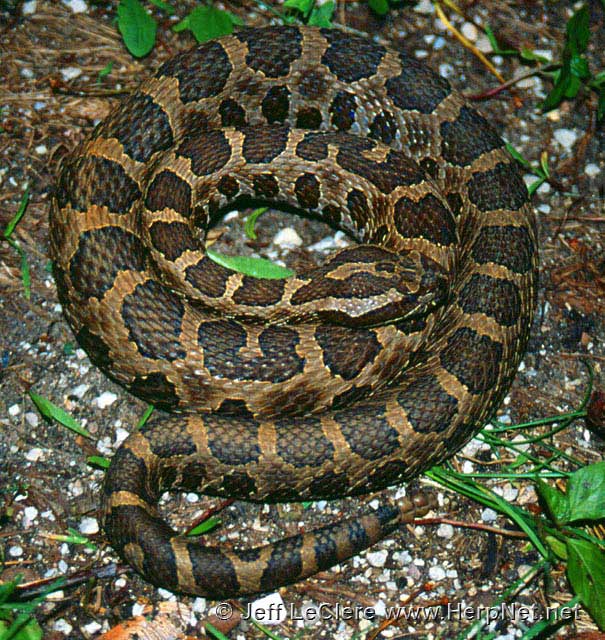
Eastern massasaugas are stout bodied snakes with a triangular shaped head. The pupils are vertically elliptical and there is a heat sensitive pit located between the eye and nostril. This pit is larger and positioned lower on the face than the nostril. There is a rattle at the end of the tail. The rattle is comprised of a series of interlocking keratinous segments that make a buzzing noise when the tail is vibrated. The scales are keeled and the anal plate is single.
This snake may be quite difficult to distinguish from the harmless western fox and water snakes. One may look for a rattle at the end of the tail, but massasaugas usually have small, dark rattles that are not always distinctive. Eastern massasaugas will rattle with their tails off the ground (though not as high as other rattlesnake species). Harmless snakes that vibrate their tails must hold their tails close to the ground to produce noise. The best thing to do is leave it be if you are unsure of what species it is.
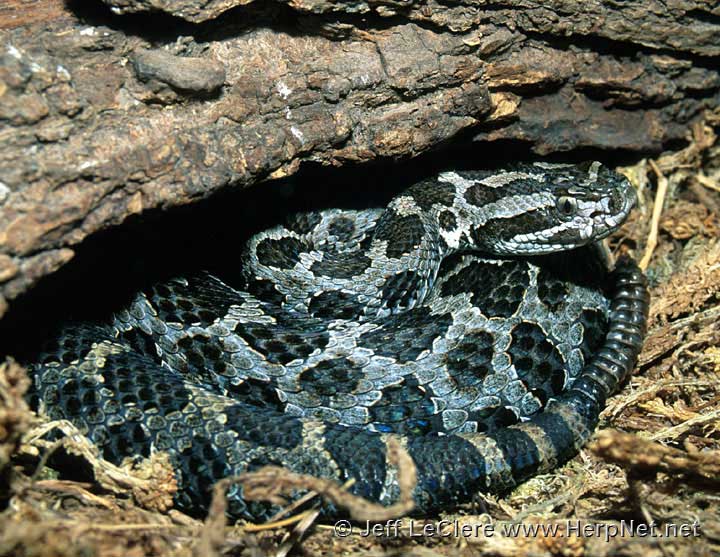
Subspecies
No subspecies are currently recognized.
Range
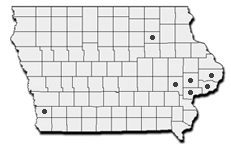
Eastern massasaugas are rare in Iowa. There were larger populations in eastern Iowa, and throughout southern Iowa. Today, these populations are reduced to less than a half dozen scattered about eastern and southeastern Iowa. The southwestern record is for the western massasauga, Sistrurus tergeminus.
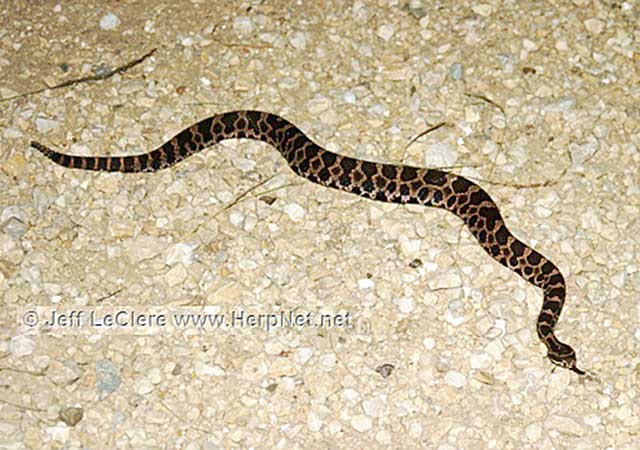
If you see an eastern massasauga in Iowa, do not kill or harm it in any way. Also, do not attempt to catch or move it. It may be a useful record, however. If you wish to report it, try to take a good picture of it. If the specimen is found dead, a good photo of a dead snake will suffice! Most importantly, give clear and exact locality documentation, and report it to the DNR, or us
Habitat
Most authors seem to agree that eastern massasaugas overwinter near or in low, swampy areas close to marshes, lakes, and rivers. This is the habitat in which I find them in Iowa. During the active season, they elevate themselves and may be found in open grasslands, meadows, or dry woodlands, even farms. The majority prefer to sit in tufts of grass or under rocks a short distance from the water. Bailey (1944) found specimens well away from water when they had a more expansive range in the state.
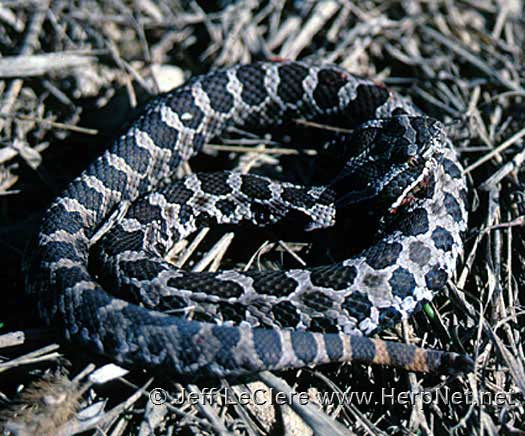
Habits
Some references state that eastern massasaugas are slow, sluggish snakes that are quite passive and slow to rattle or strike. They rely on their coloration for camouflage to avoid detection. One may almost step on this snake before evoking a reaction from it. I have found that they are diverse in their behavior as some will rattle at the least provocation and strike repeatedly. One specimen, however was found after a friend had stepped right over it. It did not rattle until afterward when I tossed a cover board on it! The eastern massasauga’s rattle is small, and sometimes can only be heard at relatively close distances.
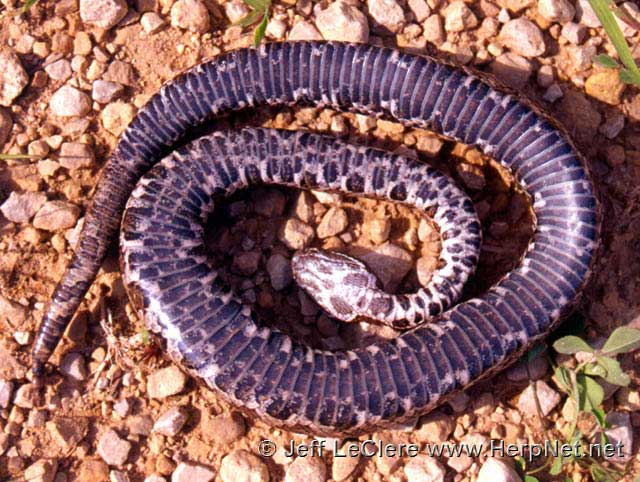
This snake is generally diurnal except during hot weather. They seem to enjoy warm overcast weather as this is the condition under which many specimens were found. Mornings are a good time to look for basking eastern massasaugas. They may take shelter under rocks, logs, pieces of bark, under piles of brush, muskrat houses, or in crayfish burrows.
They breed in the spring or fall. They may only breed every other year or less and are sexually mature at the age of three or four. They give birth to living young (ovoviviparous). The young number from 5 – 24 and are about 5 – 7 inches in length. The young are equipped with fangs and are venomous as soon as they are born. They are usually brighter colored than the adults. Instead of overwintering communally, like many species of snakes, they often overwinter singly in mammal, or, more commonly, crayfish burrows and other areas where they can gauge the water line. It is reported that they emerge with the spring flooding and basically follow the water line during this time.
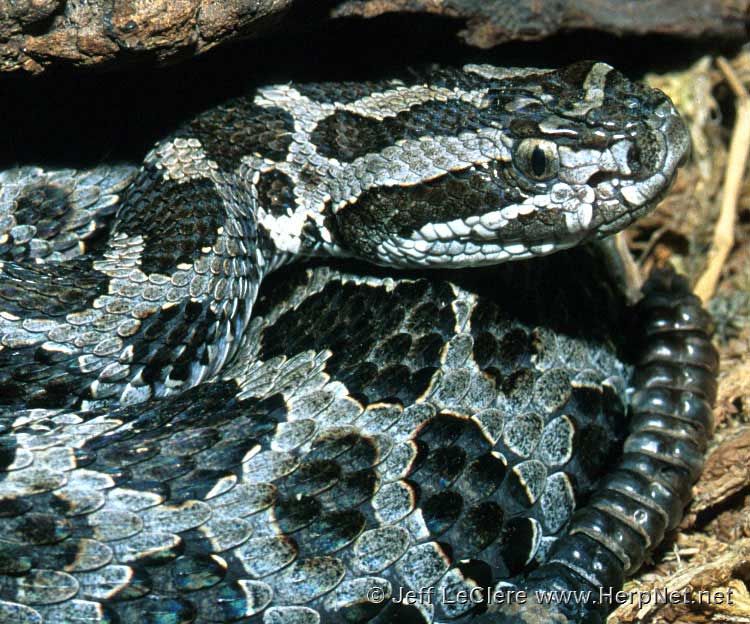
Food
The diet of the eastern massasauga is comprised largely of small mammals, but small birds, and other snakes are also consumed. While adults usually feed upon rodents, small snakes are an important food item for young eastern massasaugas. It is interesting to note that this snake will often bite and release adult rodents then search them out and swallow them after they are dead. When birds, lizards, and snakes are to be consumed, they are held in the snake’s jaws until the venom takes effect or are eaten immediately.